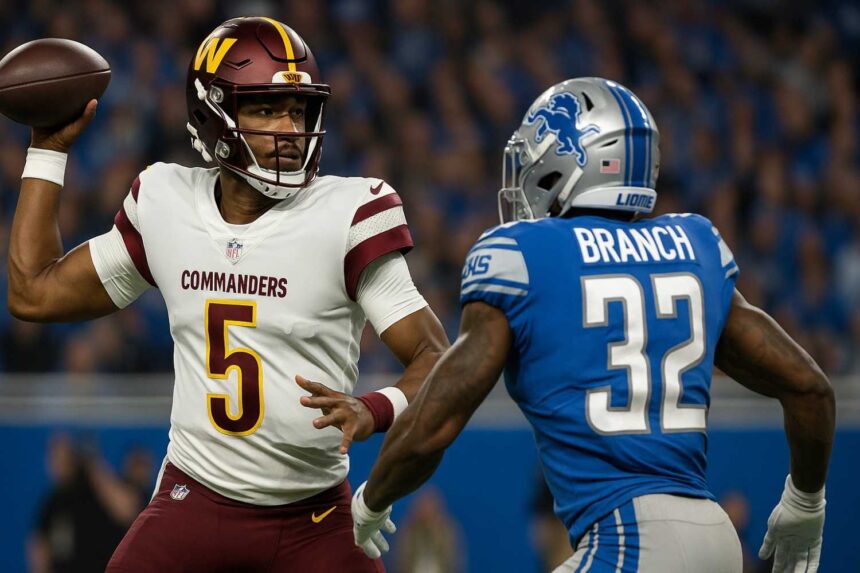The Washington Commanders vs Detroit Lions match player stats from the NFC Divisional Round on January 18, 2025, gave fans one of the most thrilling playoff upsets of the season. The Commanders, led by rookie quarterback Jayden Daniels, defeated the Detroit Lions 45–31 at Ford Field in Detroit, Michigan. This win marked Washington’s first road playoff victory in over two decades and sent them to the NFC Championship for the first time since 1991.
From the start, this game had high offensive intensity, with both teams combining for over 1,000 total yards. Washington stunned Detroit early with a defensive touchdown and kept the pressure on with big plays on both offense and defense. While the Lions posted more total yardage, Washington was more efficient when it mattered most, converting key fourth downs and capitalizing on Detroit’s turnovers. The Commanders didn’t just win—they outcoached and outplayed a favored Lions team in their own stadium.
Here’s a snapshot of the final team stats:
| Category | Washington Commanders | Detroit Lions |
|---|---|---|
| Final Score | 45 | 31 |
| Total Yards | 481 | 521 |
| Passing Yards | 299 | 313 |
| Rushing Yards | 182 | 201 |
| Turnovers Committed | 0 | 4 |
| Turnovers Forced | 5 | 0 |
| Third-Down Conversions | 4 / 12 | 3 / 9 |
| Fourth-Down Conversions | 3 / 4 | 2 / 2 |
| Time of Possession | 31:42 | 28:18 |
What made the Commanders’ performance stand out wasn’t just the scoreboard, but how they won—through discipline, opportunism, and strong coaching. The Lions moved the ball well but failed to protect it, while Washington maintained composure and executed with precision in high-pressure moments.

Key Player Performances – Washington Commanders
The Washington Commanders vs Detroit Lions match player stats spotlighted the rise of rookie quarterback Jayden Daniels, who delivered a masterful performance under playoff pressure. He completed 22 of 31 passes for 299 yards, threw 2 touchdowns, and did not commit a turnover. Beyond the numbers, what stood out was his poise in the pocket, smart decision-making, and effective use of his legs to escape pressure. Daniels also added 51 rushing yards, which kept drives alive and frustrated the Lions’ defensive front.
One of his most impactful moments came in the second quarter when he led a 92-yard drive that ended in a touchdown to Terry McLaurin, showcasing his ability to read coverages and make accurate throws downfield. His performance was one of the best ever by a rookie quarterback in a postseason game.
Washington Commanders Top Offensive Performers
| Player | Stat Line |
|---|---|
| Jayden Daniels | 22/31, 299 yds, 2 TD, 51 rush yds |
| Terry McLaurin | 7 rec, 103 yds, 1 TD |
| Brian Robinson Jr. | 19 rush, 85 yds, 1 TD |
| Jahan Dotson | 4 rec, 67 yds |
On the ground, Brian Robinson Jr. was critical in maintaining balance. He powered through Detroit’s defensive line with tough, inside runs and added a rushing touchdown in the third quarter. The receiving corps, led by Terry McLaurin, made clutch catches that extended drives. McLaurin’s route running and yards after catch ability were vital in breaking through the Lions’ secondary.
Washington Commanders Defensive Standouts
The defense played a pivotal role in the outcome. Quan Martin delivered a momentum-shifting moment with a 40-yard interception return for a touchdown, helping Washington seize control early. The defensive line applied consistent pressure, with two key sacks coming at critical third-down situations.
| Player | Key Defensive Stats |
|---|---|
| Quan Martin | 1 INT, 1 TD (Pick-6), 3 tackles |
| Kamren Curl | 6 tackles, 1 pass deflection |
| Jonathan Allen | 1 sack, 3 QB pressures |
Their ability to force five turnovers (3 INTs and 2 fumbles) completely disrupted the Lions’ rhythm and gave Washington multiple short fields to capitalize on.
Key Player Performances – Detroit Lions
Despite the loss, several Detroit Lions player stats were impressive on paper. Quarterback Jared Goff threw for 313 yards and 1 touchdown, completing 23 of 40 passes, but he also had 3 interceptions and 1 fumble, which turned out to be game-changing. Goff struggled under pressure, especially in the second half, where two of his interceptions came on back-to-back drives.
Detroit Lions Offensive Leaders
| Player | Stat Line |
|---|---|
| Jared Goff | 23/40, 313 yds, 1 TD, 3 INT, 1 FUM |
| Jahmyr Gibbs | 14 rush, 105 yds, 2 TD; 4 rec, 70 yds |
| Amon-Ra St. Brown | 8 rec, 137 yds |
| Sam LaPorta | 5 rec, 49 yds |
Jahmyr Gibbs had one of the best all-around performances of the night. He rushed for over 100 yards and scored two touchdowns, including a 31-yard burst that showcased his elite speed and vision. He also added value in the receiving game, showing he’s one of the most dynamic young backs in the league.
Amon-Ra St. Brown was a constant target and finished with 137 receiving yards, though Washington’s secondary kept him out of the end zone. Rookie tight end Sam LaPorta provided reliable hands across the middle but couldn’t break any big plays.
Detroit Lions Defensive Stats
Defensively, the Lions struggled to contain Daniels and Robinson. Brian Branch led the team with 7 tackles, but Detroit failed to force a single turnover or sack, which ultimately put too much pressure on the offense to respond.
| Player | Defensive Highlights |
|---|---|
| Brian Branch | 7 tackles, 1 TFL |
| Aidan Hutchinson | 1 QB hit, no sacks |
| Alex Anzalone | 6 tackles, 1 pass defensed |
Without disruption at the line or any takeaways, the defense allowed long drives that tired them out over four quarters.
Read More: oakland athletics vs los angeles angels match player stats
Advanced Team Statistics & Efficiency Metrics
While the raw yardage favored Detroit, Washington outperformed in situational football, especially in turnover margin and fourth-down efficiency. These metrics are crucial in the postseason when one or two plays can swing momentum entirely.
| Advanced Metrics | Commanders | Lions |
|---|---|---|
| Yards per Play | 6.1 | 6.8 |
| Turnover Margin | +5 | -5 |
| 3rd Down Conversion Rate | 33% (4/12) | 33% (3/9) |
| 4th Down Conversion Rate | 75% (3/4) | 100% (2/2) |
| Red Zone Efficiency | 4 TDs on 5 trips | 3 TDs on 4 trips |
| Sacks Allowed | 0 | 2 |
Turnovers and discipline were the main difference. Despite Detroit averaging more yards per play, their mistakes gave Washington easier scoring opportunities. Meanwhile, the Commanders’ offense avoided negative plays, and the defense turned pressure into game-changing turnovers.
This contrast of efficiency vs explosiveness defined the game’s outcome.
Momentum Shifts & Highlight Plays
The Washington Commanders vs Detroit Lions match player stats tell one part of the story—but the game’s rhythm, momentum swings, and critical plays reveal the full drama. This matchup featured several game-defining moments that flipped control multiple times, especially in the first half.
The first big swing came midway through the first quarter, when Quan Martin intercepted Jared Goff and returned it 40 yards for a touchdown, giving Washington an early 14–7 lead. This play not only shifted momentum but also set the tone for how opportunistic the Commanders’ defense would be the rest of the night.
In the second quarter, after a long Detroit drive ended in a field goal, Washington responded with a 92-yard touchdown drive, capped by a 26-yard touchdown pass from Jayden Daniels to Terry McLaurin. This extended the lead to 21–10 and put the Lions on the back foot.
The third quarter featured the Lions’ biggest moment—a dazzling 31-yard touchdown run by Jahmyr Gibbs, slicing through defenders with elite acceleration. This cut the Commanders’ lead to 24–17 and brought the Detroit crowd back into it.
However, that energy faded fast when Washington answered with a long drive of their own, including two fourth-down conversions and ending in a rushing touchdown by Brian Robinson Jr. That 75-yard drive took over seven minutes and sapped the Lions’ momentum again.
In the fourth quarter, Goff’s third interception—tipped and caught by Kamren Curl—effectively ended Detroit’s comeback hopes. Washington added another touchdown on a short field after the turnover, sealing the game at 45–31.
Top Highlight Plays of the Game
- Quan Martin’s Pick-6 (1st Quarter) – Turned early tie into Commanders’ lead
- Terry McLaurin TD Catch (2nd Quarter) – Showcased elite route timing and touch from Daniels
- Jahmyr Gibbs’ 31-Yard TD Run (3rd Quarter) – Explosive reminder of Detroit’s talent
- Back-to-Back 4th-Down Conversions by Washington (3rd Quarter) – Drive-sustaining gutsy calls
- Kamren Curl INT (4th Quarter) – Final dagger to Detroit’s comeback
Each of these moments didn’t just show skill—they shifted emotion, crowd energy, and coaching confidence, making them more impactful than any single stat line could suggest.
Historical Head‑to‑Head & Playoff Context
To understand how meaningful this game was, it’s helpful to look at the history of the Washington Commanders vs Detroit Lions match player stats and outcomes. Coming into this game, the Lions had dominated recent matchups, winning 6 of the last 7 meetings dating back to 2011. Washington hadn’t beaten Detroit since 2008 prior to this playoff stunner.
But the historical context runs even deeper. The Commanders hadn’t advanced to an NFC Championship since their Super Bowl-winning 1991 season. This win not only broke a playoff drought—it redefined expectations around their rebuild and especially their young quarterback.
For Detroit, this game was supposed to be a culmination of their recent rise. Under Dan Campbell, they had built a gritty, physical identity. They’d won the NFC North and looked primed for a deep postseason run. But this loss, particularly in front of their home crowd, brought a painful end to what had been an inspiring season.
Recent Head-to-Head Record
| Year | Result | Location |
|---|---|---|
| 2025 | WAS 45 – DET 31 (Playoffs) | Ford Field |
| 2022 | DET 36 – WAS 27 (Regular Season) | Ford Field |
| 2020 | DET 30 – WAS 27 | Ford Field |
| 2016 | DET 20 – WAS 17 | Ford Field |
| 2013 | DET 27 – WAS 20 | FedEx Field |
This win was more than a statistical anomaly—it was a statement game. It altered the playoff landscape and validated the Commanders’ long-term investment in youth, speed, and smart coaching.
What Went Right / What Went Wrong – Tactical Analysis
The outcome of this game can be traced directly to execution, turnover battle, and coaching decisions. From a tactical perspective, Washington did almost everything right, while Detroit’s mistakes magnified under playoff pressure.
What Went Right for Washington:
- Aggressive Playcalling: Washington went for it on fourth down four times, converting three. These gutsy calls extended drives and led to scores.
- Ball Security: They had zero turnovers. That alone was a 5-possession swing in comparison to Detroit.
- Quarterback Control: Jayden Daniels was decisive, mobile, and avoided sacks. He neutralized Detroit’s defensive line with quick throws and scrambles.
- Defensive Opportunism: Forcing five turnovers, including a pick-six, was the ultimate difference-maker.
What Went Wrong for Detroit:
- Turnovers: Goff’s 3 interceptions and a lost fumble killed four potential scoring drives.
- Defensive Inconsistency: They allowed over 180 rushing yards and failed to get pressure on Daniels.
- Failure to Adjust: As the game wore on, the Lions continued running zone coverages, which Daniels picked apart. Blitzes were rare and ineffective.
- Poor Situational Execution: Despite strong yardage totals, they couldn’t convert in key moments—third downs, red zone trips, and after turnovers.
Coaching Contrast
Ron Rivera and his staff called a nearly perfect game—aggressive when needed, conservative when smart. In contrast, Dan Campbell’s Lions didn’t adapt well once they fell behind. Washington adjusted at halftime. Detroit didn’t.
What Fans & Analysts Said
The football world was stunned by the result. Analysts praised Jayden Daniels’ maturity and the Commanders’ ability to win in every phase of the game. Meanwhile, fans and reporters were quick to question Detroit’s preparation, particularly Jared Goff’s mistakes and the defensive approach.
Expert Quotes:
“Jayden Daniels didn’t look like a rookie—he looked like a franchise quarterback.”
— NFL Network Analyst Daniel Jeremiah
“The Commanders were faster, smarter, and tougher. That’s a dangerous combination in January.”
— ESPN’s Mina Kimes
“If you lose the turnover battle by five, you’re not winning playoff games. Period.”
— Dan Orlovsky, former Lions QB
On Reddit and fan forums, Lions fans pointed to missed opportunities, especially the first-half turnovers. Commanders fans celebrated a rare playoff triumph, hoping it signals the end of their decades-long struggles.
Frequently Asked Questions (FAQs)
What were Jayden Daniels’ stats vs Lions?
22 completions, 299 yards, 2 touchdowns, 0 interceptions, and 51 rushing yards.
Who led the Lions in rushing yards?
Jahmyr Gibbs with 105 rushing yards and 2 touchdowns.
How many turnovers did Detroit have?
Four—three interceptions and one lost fumble.
Which defensive player scored for Washington?
Quan Martin with a 40-yard pick-six in the first quarter.
Did the Commanders win despite fewer yards?
Yes. Detroit had more total yards, but Washington forced turnovers and converted key downs.
Summary & Takeaways
The Washington Commanders vs Detroit Lions match player stats show a clash of potential and precision. Detroit entered with momentum, home-field advantage, and more yardage—but Washington played smarter, tougher football. Led by Jayden Daniels’ breakout, a defense that forced five turnovers, and coaching that took calculated risks, the Commanders turned a postseason matchup into a statement win.
For the Lions, the loss stings. It was a missed opportunity in a year filled with promise. For the Commanders, it’s a launchpad. A young team with heart and hunger just showed the NFL that it’s ready for the big stage—and the numbers prove it.






